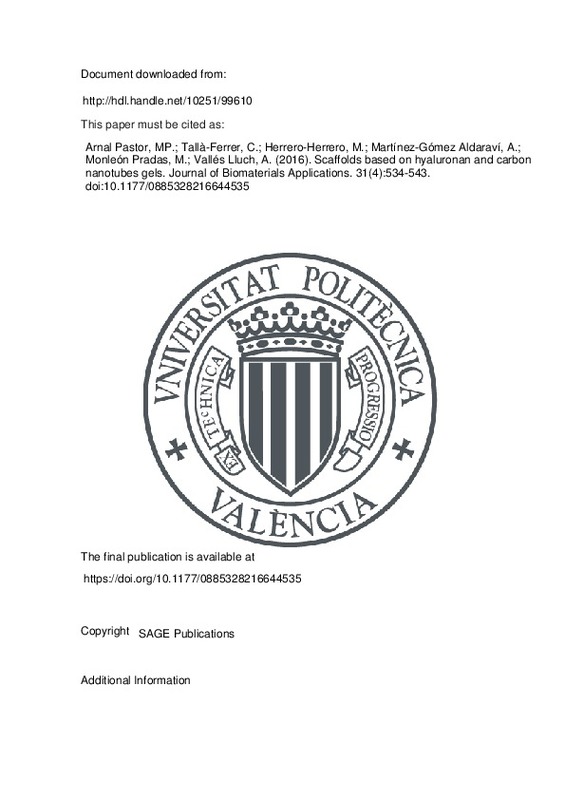JavaScript is disabled for your browser. Some features of this site may not work without it.
Buscar en RiuNet
Listar
Mi cuenta
Estadísticas
Ayuda RiuNet
Admin. UPV
Scaffolds based on hyaluronan and carbon nanotubes gels
Mostrar el registro sencillo del ítem
Ficheros en el ítem
| dc.contributor.author | Arnal Pastor, María Pilar
|
es_ES |
| dc.contributor.author | Tallà-Ferrer, C.
|
es_ES |
| dc.contributor.author | Herrero-Herrero, María
|
es_ES |
| dc.contributor.author | Martínez-Gómez Aldaraví, A.
|
es_ES |
| dc.contributor.author | Monleón Pradas, Manuel
|
es_ES |
| dc.contributor.author | Vallés Lluch, Ana
|
es_ES |
| dc.date.accessioned | 2018-03-23T05:15:54Z | |
| dc.date.available | 2018-03-23T05:15:54Z | |
| dc.date.issued | 2016 | es_ES |
| dc.identifier.issn | 0885-3282 | es_ES |
| dc.identifier.uri | http://hdl.handle.net/10251/99610 | |
| dc.description.abstract | [EN] Physico-chemical and mechanical properties of hyaluronic acid/carbon nanotubes nanohybrids have been correlated with the proportion of inorganic nanophase and the preparation procedure. The mass fraction of -COOH functionalized carbon nanotubes was varied from 0 to 0.05. Hyaluronic acid was crosslinked with divinyl sulfone to improve its stability in aqueous media and allow its handling as a hydrogel. A series of samples was dried by lyophilization to obtain porous scaffolds whereas another was room-dried allowing the collapse of the hybrid structures. The porosity of the former, together with the tighter packing of hyaluronic acid chains, results in a lower water absorption and lower mechanical properties in the swollen state, because of the easier water diffusion. The presence of even a small amount of carbon nanotubes (mass fraction of 0.05) limits even more the swelling of the matrix, owing probably to hybrid interactions. These nanohybrids do not seem to degrade significantly during 14 days in water or enzymatic medium. | es_ES |
| dc.description.sponsorship | The author(s) disclosed receipt of the following financial support for the research, authorship, and/or publication of this article: Contract grant sponsor: Spanish Ministerio de Economia y Competitividad; contract grant numbers: MAT2011-28791-C03-02 and -03. | es_ES |
| dc.language | Inglés | es_ES |
| dc.publisher | SAGE Publications | es_ES |
| dc.relation.ispartof | Journal of Biomaterials Applications | es_ES |
| dc.rights | Reserva de todos los derechos | es_ES |
| dc.subject | Hyaluronic acid | es_ES |
| dc.subject | Carbon nanotubes | es_ES |
| dc.subject | Nanohybrid | es_ES |
| dc.subject | Scaffold | es_ES |
| dc.subject | Lyophilization | es_ES |
| dc.subject.classification | TERMODINAMICA APLICADA (UPV) | es_ES |
| dc.subject.classification | MAQUINAS Y MOTORES TERMICOS | es_ES |
| dc.title | Scaffolds based on hyaluronan and carbon nanotubes gels | es_ES |
| dc.type | Artículo | es_ES |
| dc.identifier.doi | 10.1177/0885328216644535 | es_ES |
| dc.relation.projectID | info:eu-repo/grantAgreement/MICINN//MAT2011-28791-C03-02/ES/MATERIALES DE SOPORTE Y LIBERACION CONTROLADA PARA LA REGENERACION DE ESTRUCTURAS NEURALES AFECTADAS POR ICTUS/ | es_ES |
| dc.relation.projectID | info:eu-repo/grantAgreement/MICINN//MAT2011-28791-C03-03/ES/CONSTRUCTOS PARA LA REGENERACION GUIADA DE ESTRUCTURAS DEL SISTEMA NERVIOSO CENTRAL/ | es_ES |
| dc.rights.accessRights | Abierto | es_ES |
| dc.contributor.affiliation | Universitat Politècnica de València. Departamento de Termodinámica Aplicada - Departament de Termodinàmica Aplicada | es_ES |
| dc.description.bibliographicCitation | Arnal Pastor, MP.; Tallà-Ferrer, C.; Herrero-Herrero, M.; Martínez-Gómez Aldaraví, A.; Monleón Pradas, M.; Vallés Lluch, A. (2016). Scaffolds based on hyaluronan and carbon nanotubes gels. Journal of Biomaterials Applications. 31(4):534-543. https://doi.org/10.1177/0885328216644535 | es_ES |
| dc.description.accrualMethod | S | es_ES |
| dc.relation.publisherversion | https://doi.org/10.1177/0885328216644535 | es_ES |
| dc.description.upvformatpinicio | 534 | es_ES |
| dc.description.upvformatpfin | 543 | es_ES |
| dc.type.version | info:eu-repo/semantics/publishedVersion | es_ES |
| dc.description.volume | 31 | es_ES |
| dc.description.issue | 4 | es_ES |
| dc.relation.pasarela | S\325377 | es_ES |
| dc.contributor.funder | Ministerio de Ciencia e Innovación | es_ES |







![[Cerrado]](/themes/UPV/images/candado.png)

